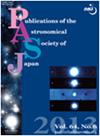研究旧 GeV 超新星残余 G298.6-0.0 的辐射壳和分子云的强子 γ 射线方案
IF 2.2
4区 物理与天体物理
Q2 ASTRONOMY & ASTROPHYSICS
引用次数: 0
摘要
基于13.7年的费米-LAT数据,Yeung、Bamba和Sano(2023,PASJ,75,384)声称探测到了两个与超新星残余(SNR)G298.6-0.0相关的γ射线源(即Src-NE和Src-NW),并将其解释为一个与分子云(MC)相互作用的旧GeV SNR。在这项后续研究中,我们利用费米-LAT事件类型改进了2 GeV以下的通量测量,以获得更好的角度重建。然后,我们报告了在强子情景下的γ射线光谱拟合和宇宙射线现象学,同时考虑了SNR G298.6-0.0的壳区和MC区。我们证实Src-NE和Src-NW的γ射线谱线都表现出谱线断裂,分别为$1.50_{-0.50}^{+0.60}$和$0.68_{-0.11}^{+0.32}:$GeV。Src-NW的宽带光子指数比Src-NE要高,这表明它们各自的发射场与SNR G298.6-0.0的物理距离有明显的不同。Src-NE的宇宙射线频谱从最低能量$E_\mathrm{CR,min}=1.38_{-0.16}^{+0.47}/:$GeV开始,质子指数$\Gamma _\mathrm{CR}=2.57_{-0.21}^{+0.18}$低于指数截止能量$E_\mathrm{CR,max}=240_{-150}^{+240}/:$GeV。因此,我们认为Src-NE是由SNR外壳主导的,而与SNR相互作用的MC只贡献了一小部分低能发射。Src-NW的宇宙射线群开始于较高的能量,因此Src-NW与Src-NE的ECR,min比值为≳2。高ECR,min和所需的高宇宙射线能量密度(∼26 eV cm-3)支持这样的解释,即Src-NW主要是来自较远的MC的γ射线发射,这些MC受到了早先从SNR G298.6-0.0逃逸出来的质子的轰击。通过将 G298.6-0.0 的高能特征与同类 SNR(尤其是 SNR W 28 和 SNR W 44)的高能特征进行比较,我们进一步推测 SNR G298.6-0.0 的年龄为 10-30 kyr(假设为纯强子情况)。本文章由计算机程序翻译,如有差异,请以英文原文为准。
Examining a hadronic γ-ray scenario for the radiative shell and molecular clouds of the old GeV supernova remnant G298.6−0.0
Based on the 13.7 yr Fermi-LAT data, Yeung, Bamba, and Sano (2023, PASJ, 75, 384) claimed detection of two γ-ray sources (namely Src-NE and Src-NW) associated with the supernova remnant (SNR) G298.6−0.0, and interpreted it as an old GeV SNR interacting with molecular clouds (MCs). In this follow-up study, we refine the flux measurements below 2 GeV with Fermi-LAT event types of better angular reconstruction. Then, we report our γ-ray spectral fittings and cosmic-ray phenomenology in a hadronic scenario, considering both the shell and MC regions of SNR G298.6−0.0. We confirm that the γ-ray spectra of both Src-NE and Src-NW exhibit spectral breaks, at $1.50_{-0.50}^{+0.60}$ and $0.68_{-0.11}^{+0.32}\:$GeV, respectively. Src-NW has a harder broad-band photon index than Src-NE, suggesting an appreciable difference between the physical separations of their respective emission sites from SNR G298.6−0.0. The cosmic-ray spectrum responsible for Src-NE starts with a minimum energy $E_\mathrm{CR,min}=1.38_{-0.16}^{+0.47}\:$GeV, and has a proton index $\Gamma _\mathrm{CR}=2.57_{-0.21}^{+0.18}$ below the exponential cutoff energy $E_\mathrm{CR,max}=240_{-150}^{+240}\:$GeV. Accordingly, we argue that Src-NE is dominated by the SNR shell, while only a minor portion of lower-energy emission is contributed by the MCs interacting with the SNR. The cosmic-ray population for Src-NW starts at a higher energy such that the ECR, min ratio of Src-NW to Src-NE is ≳2. The high ECR, min, as well as the high cosmic-ray energy density required (∼26 eV cm−3), supports the interpretation that Src-NW is predominantly the γ-ray emission from the farther MCs being bombarded by protons that had earlier escaped from SNR G298.6−0.0. By comparing the high-energy features of G298.6−0.0 with those of analogical SNRs, especially SNR W 28 and SNR W 44, we further constrain the age of SNR G298.6−0.0 to be 10–30 kyr, under the assumption of a purely hadronic scenario.
求助全文
通过发布文献求助,成功后即可免费获取论文全文。
去求助
来源期刊

Publications of the Astronomical Society of Japan
地学天文-天文与天体物理
CiteScore
4.10
自引率
13.00%
发文量
98
审稿时长
4-8 weeks
期刊介绍:
Publications of the Astronomical Society of Japan (PASJ) publishes the results of original research in all aspects of astronomy, astrophysics, and fields closely related to them.
 求助内容:
求助内容: 应助结果提醒方式:
应助结果提醒方式:


